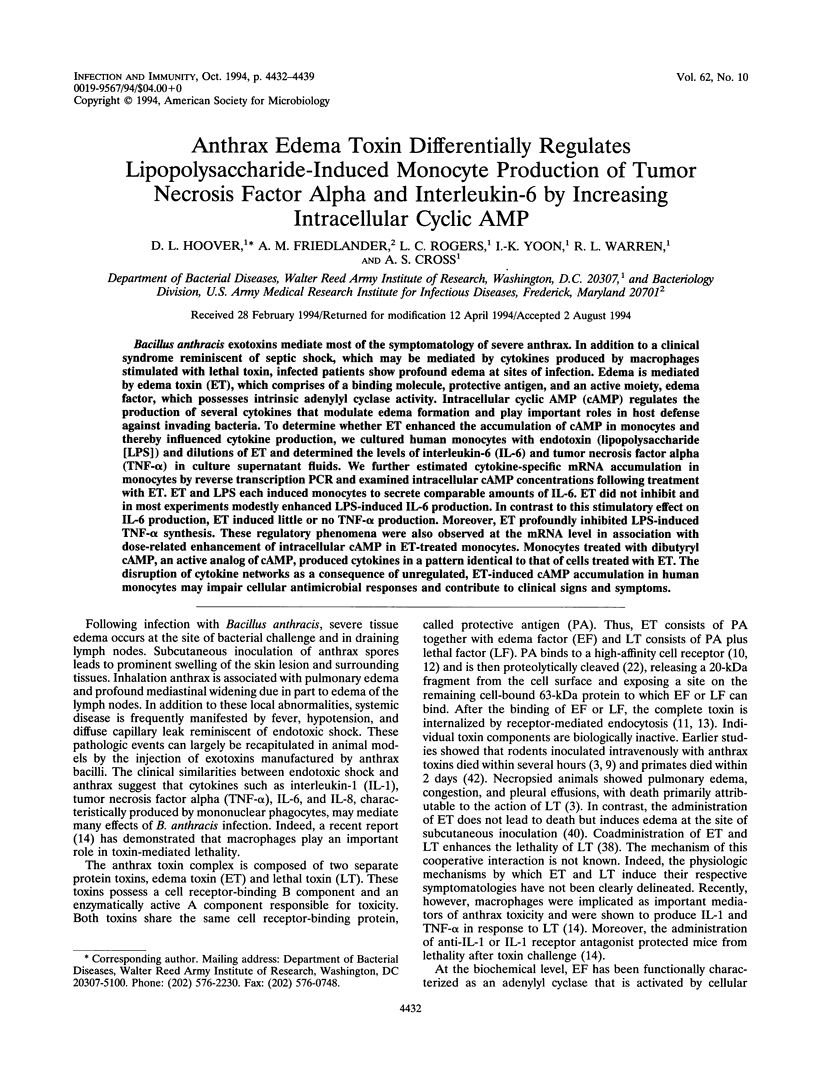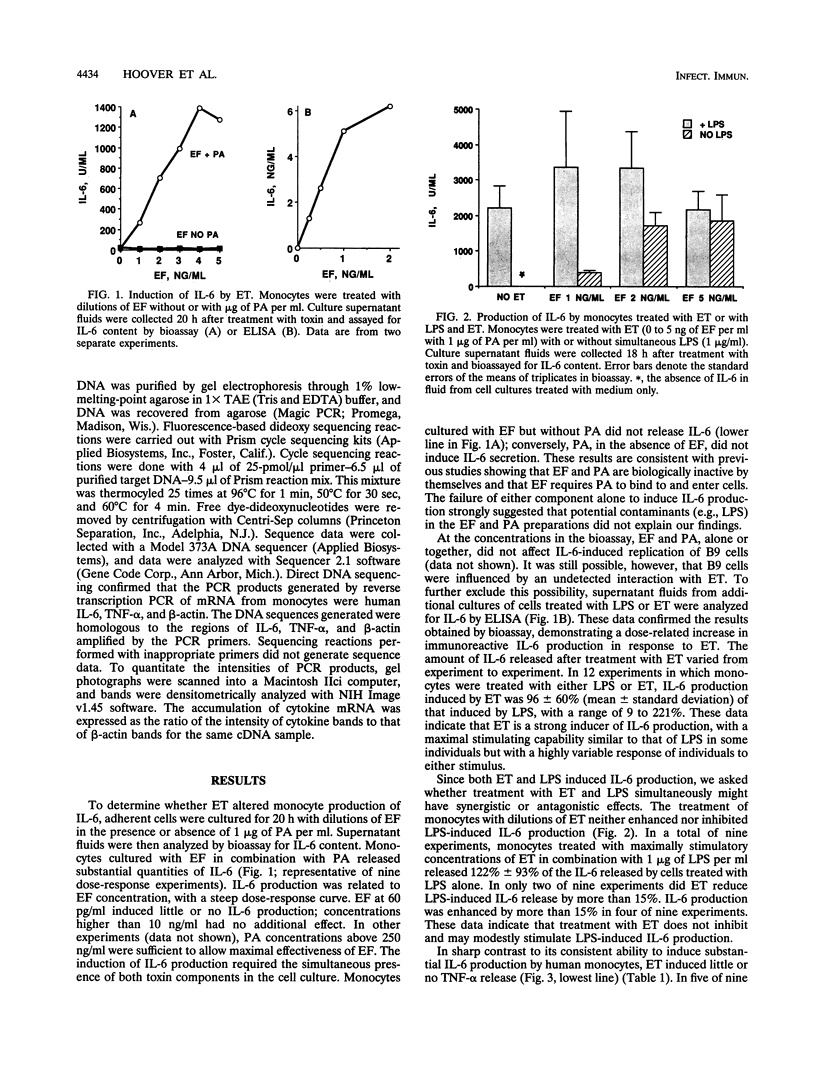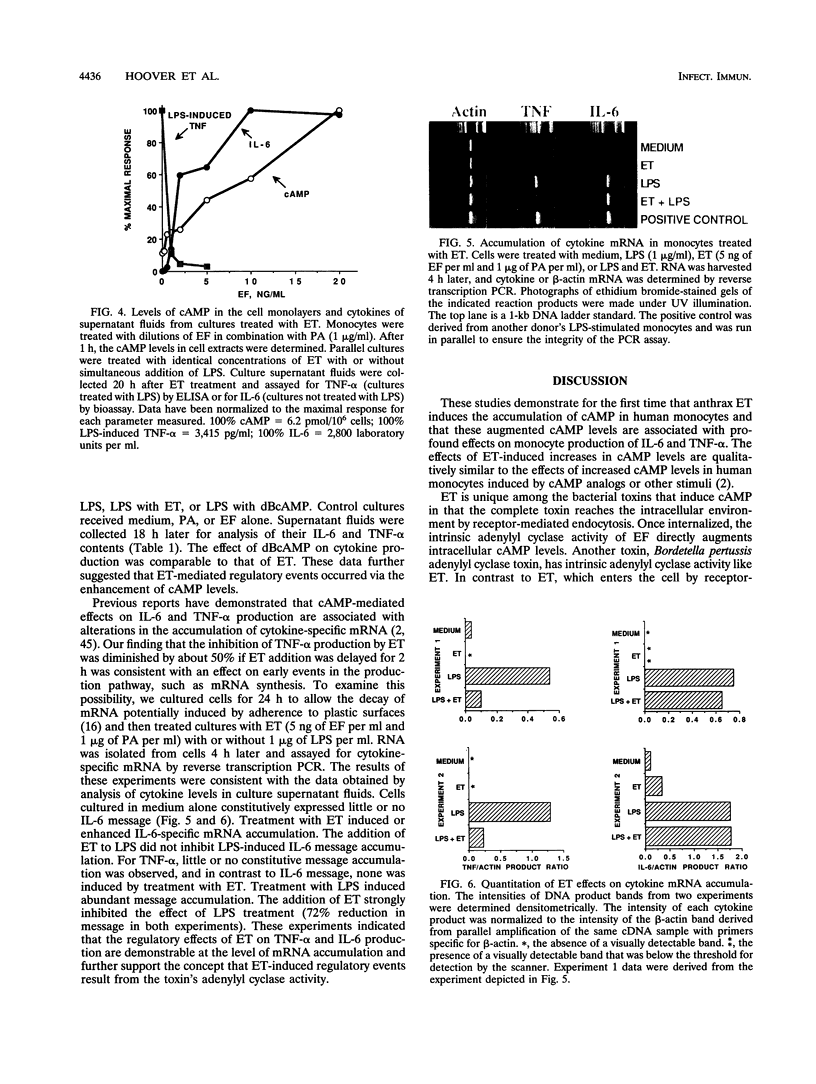Abstract
Bacillus anthracis exotoxins mediate most of the symptomatology of severe anthrax. In addition to a clinical syndrome reminiscent of septic shock, which may be mediated by cytokines produced by macrophages stimulated with lethal toxin, infected patients show profound edema at sites of infection. Edema is mediated by edema toxin (ET), which comprises of a binding molecule, protective antigen, and an active moiety, edema factor, which possesses intrinsic adenylyl cyclase activity. Intracellular cyclic AMP (cAMP) regulates the production of several cytokines that modulate edema formation and play important roles in host defense against invading bacteria. To determine whether ET enhanced the accumulation of cAMP in monocytes and thereby influenced cytokine production, we cultured human monocytes with endotoxin (lipopolysaccharide [LPS]) and dilutions of ET and determined the levels of interleukin-6 (IL-6) and tumor necrosis factor alpha (TNF-alpha) in culture supernatant fluids. We further estimated cytokine-specific mRNA accumulation in monocytes by reverse transcription PCR and examined intracellular cAMP concentrations following treatment with ET. ET and LPS each induced monocytes to secrete comparable amounts of IL-6. ET did not inhibit and in most experiments modestly enhanced LPS-induced IL-6 production. In contrast to this stimulatory effect on IL-6 production, ET induced little or no TNF-alpha production. Moreover, ET profoundly inhibited LPS-induced TNF-alpha synthesis. These regulatory phenomena were also observed at the mRNA level in association with dose-related enhancement of intracellular cAMP in ET-treated monocytes. Monocytes treated with dibutyryl cAMP, an active analog of cAMP, produced cytokines in a pattern identical to that of cells treated with ET. The disruption of cytokine networks as a consequence of unregulated, ET-induced cAMP accumulation in human monocytes may impair cellular antimicrobial responses and contribute to clinical signs and symptoms.
Full text
PDF







Images in this article
Selected References
These references are in PubMed. This may not be the complete list of references from this article.
- Akira S., Isshiki H., Sugita T., Tanabe O., Kinoshita S., Nishio Y., Nakajima T., Hirano T., Kishimoto T. A nuclear factor for IL-6 expression (NF-IL6) is a member of a C/EBP family. EMBO J. 1990 Jun;9(6):1897–1906. doi: 10.1002/j.1460-2075.1990.tb08316.x. [DOI] [PMC free article] [PubMed] [Google Scholar]
- BEALL F. A., TAYLOR M. J., THORNE C. B. Rapid lethal effect in rats of a third component found upon fractionating the toxin of Bacillus anthracis. J Bacteriol. 1962 Jun;83:1274–1280. doi: 10.1128/jb.83.6.1274-1280.1962. [DOI] [PMC free article] [PubMed] [Google Scholar]
- Bailly S., Ferrua B., Fay M., Gougerot-Pocidalo M. A. Differential regulation of IL 6, IL 1 A, IL 1 beta and TNF alpha production in LPS-stimulated human monocytes: role of cyclic AMP. Cytokine. 1990 May;2(3):205–210. doi: 10.1016/1043-4666(90)90017-n. [DOI] [PubMed] [Google Scholar]
- Bermudez L. E., Young L. S. Tumor necrosis factor, alone or in combination with IL-2, but not IFN-gamma, is associated with macrophage killing of Mycobacterium avium complex. J Immunol. 1988 May 1;140(9):3006–3013. [PubMed] [Google Scholar]
- Buckley T. L., Brain S. D., Collins P. D., Williams T. J. Inflammatory edema induced by interactions between IL-1 and the neuropeptide calcitonin gene-related peptide. J Immunol. 1991 May 15;146(10):3424–3430. [PubMed] [Google Scholar]
- Cassel D., Pfeuffer T. Mechanism of cholera toxin action: covalent modification of the guanyl nucleotide-binding protein of the adenylate cyclase system. Proc Natl Acad Sci U S A. 1978 Jun;75(6):2669–2673. doi: 10.1073/pnas.75.6.2669. [DOI] [PMC free article] [PubMed] [Google Scholar]
- Chomczynski P., Sacchi N. Single-step method of RNA isolation by acid guanidinium thiocyanate-phenol-chloroform extraction. Anal Biochem. 1987 Apr;162(1):156–159. doi: 10.1006/abio.1987.9999. [DOI] [PubMed] [Google Scholar]
- Cross A. S., Sadoff J. C., Kelly N., Bernton E., Gemski P. Pretreatment with recombinant murine tumor necrosis factor alpha/cachectin and murine interleukin 1 alpha protects mice from lethal bacterial infection. J Exp Med. 1989 Jun 1;169(6):2021–2027. doi: 10.1084/jem.169.6.2021. [DOI] [PMC free article] [PubMed] [Google Scholar]
- Escuyer V., Collier R. J. Anthrax protective antigen interacts with a specific receptor on the surface of CHO-K1 cells. Infect Immun. 1991 Oct;59(10):3381–3386. doi: 10.1128/iai.59.10.3381-3386.1991. [DOI] [PMC free article] [PubMed] [Google Scholar]
- Friedlander A. M., Bhatnagar R., Leppla S. H., Johnson L., Singh Y. Characterization of macrophage sensitivity and resistance to anthrax lethal toxin. Infect Immun. 1993 Jan;61(1):245–252. doi: 10.1128/iai.61.1.245-252.1993. [DOI] [PMC free article] [PubMed] [Google Scholar]
- Friedlander A. M. Macrophages are sensitive to anthrax lethal toxin through an acid-dependent process. J Biol Chem. 1986 Jun 5;261(16):7123–7126. [PubMed] [Google Scholar]
- Gordon V. M., Leppla S. H., Hewlett E. L. Inhibitors of receptor-mediated endocytosis block the entry of Bacillus anthracis adenylate cyclase toxin but not that of Bordetella pertussis adenylate cyclase toxin. Infect Immun. 1988 May;56(5):1066–1069. doi: 10.1128/iai.56.5.1066-1069.1988. [DOI] [PMC free article] [PubMed] [Google Scholar]
- Hanna P. C., Acosta D., Collier R. J. On the role of macrophages in anthrax. Proc Natl Acad Sci U S A. 1993 Nov 1;90(21):10198–10201. doi: 10.1073/pnas.90.21.10198. [DOI] [PMC free article] [PubMed] [Google Scholar]
- Hart P. H., Whitty G. A., Piccoli D. S., Hamilton J. A. Control by IFN-gamma and PGE2 of TNF alpha and IL-1 production by human monocytes. Immunology. 1989 Mar;66(3):376–383. [PMC free article] [PubMed] [Google Scholar]
- Haskill S., Johnson C., Eierman D., Becker S., Warren K. Adherence induces selective mRNA expression of monocyte mediators and proto-oncogenes. J Immunol. 1988 Mar 1;140(5):1690–1694. [PubMed] [Google Scholar]
- Helle M., Boeije L., Aarden L. A. Functional discrimination between interleukin 6 and interleukin 1. Eur J Immunol. 1988 Oct;18(10):1535–1540. doi: 10.1002/eji.1830181010. [DOI] [PubMed] [Google Scholar]
- Kasahara T., Yagisawa H., Yamashita K., Yamaguchi Y., Akiyama Y. IL1 induces proliferation and IL6 mRNA expression in a human astrocytoma cell line: positive and negative modulation by chorela toxin and cAMP. Biochem Biophys Res Commun. 1990 Mar 30;167(3):1242–1248. doi: 10.1016/0006-291x(90)90657-9. [DOI] [PubMed] [Google Scholar]
- Katakami Y., Nakao Y., Koizumi T., Katakami N., Ogawa R., Fujita T. Regulation of tumour necrosis factor production by mouse peritoneal macrophages: the role of cellular cyclic AMP. Immunology. 1988 Aug;64(4):719–724. [PMC free article] [PubMed] [Google Scholar]
- Kato K., Nakane A., Minagawa T., Kasai N., Yamamoto K., Sato N., Tsuruoka N. Human tumor necrosis factor increases the resistance against Listeria infection in mice. Med Microbiol Immunol. 1989;178(6):337–346. doi: 10.1007/BF00197452. [DOI] [PubMed] [Google Scholar]
- Klimpel K. R., Molloy S. S., Thomas G., Leppla S. H. Anthrax toxin protective antigen is activated by a cell surface protease with the sequence specificity and catalytic properties of furin. Proc Natl Acad Sci U S A. 1992 Nov 1;89(21):10277–10281. doi: 10.1073/pnas.89.21.10277. [DOI] [PMC free article] [PubMed] [Google Scholar]
- Kunkel S. L., Wiggins R. C., Chensue S. W., Larrick J. Regulation of macrophage tumor necrosis factor production by prostaglandin E2. Biochem Biophys Res Commun. 1986 May 29;137(1):404–410. doi: 10.1016/0006-291x(86)91224-6. [DOI] [PubMed] [Google Scholar]
- Leppla S. H. Anthrax toxin edema factor: a bacterial adenylate cyclase that increases cyclic AMP concentrations of eukaryotic cells. Proc Natl Acad Sci U S A. 1982 May;79(10):3162–3166. doi: 10.1073/pnas.79.10.3162. [DOI] [PMC free article] [PubMed] [Google Scholar]
- Leppla S. H. Purification and characterization of adenylyl cyclase from Bacillus anthracis. Methods Enzymol. 1991;195:153–168. doi: 10.1016/0076-6879(91)95162-d. [DOI] [PubMed] [Google Scholar]
- Martin C. A., Dorf M. E. Differential regulation of interleukin-6, macrophage inflammatory protein-1, and JE/MCP-1 cytokine expression in macrophage cell lines. Cell Immunol. 1991 Jun;135(1):245–258. doi: 10.1016/0008-8749(91)90269-h. [DOI] [PubMed] [Google Scholar]
- Murayama T., Ui M. Loss of the inhibitory function of the guanine nucleotide regulatory component of adenylate cyclase due to its ADP ribosylation by islet-activating protein, pertussis toxin, in adipocyte membranes. J Biol Chem. 1983 Mar 10;258(5):3319–3326. [PubMed] [Google Scholar]
- O'Brien J., Friedlander A., Dreier T., Ezzell J., Leppla S. Effects of anthrax toxin components on human neutrophils. Infect Immun. 1985 Jan;47(1):306–310. doi: 10.1128/iai.47.1.306-310.1985. [DOI] [PMC free article] [PubMed] [Google Scholar]
- Ohmori Y., Strassman G., Hamilton T. A. cAMP differentially regulates expression of mRNA encoding IL-1 alpha and IL-1 beta in murine peritoneal macrophages. J Immunol. 1990 Nov 15;145(10):3333–3339. [PubMed] [Google Scholar]
- Poli V., Mancini F. P., Cortese R. IL-6DBP, a nuclear protein involved in interleukin-6 signal transduction, defines a new family of leucine zipper proteins related to C/EBP. Cell. 1990 Nov 2;63(3):643–653. doi: 10.1016/0092-8674(90)90459-r. [DOI] [PubMed] [Google Scholar]
- Ray A., Sassone-Corsi P., Sehgal P. B. A multiple cytokine- and second messenger-responsive element in the enhancer of the human interleukin-6 gene: similarities with c-fos gene regulation. Mol Cell Biol. 1989 Dec;9(12):5537–5547. doi: 10.1128/mcb.9.12.5537. [DOI] [PMC free article] [PubMed] [Google Scholar]
- Renz H., Gong J. H., Schmidt A., Nain M., Gemsa D. Release of tumor necrosis factor-alpha from macrophages. Enhancement and suppression are dose-dependently regulated by prostaglandin E2 and cyclic nucleotides. J Immunol. 1988 Oct 1;141(7):2388–2393. [PubMed] [Google Scholar]
- STANLEY J. L., SMITH H. Purification of factor I and recognition of a third factor of the anthrax toxin. J Gen Microbiol. 1961 Sep;26:49–63. doi: 10.1099/00221287-26-1-49. [DOI] [PubMed] [Google Scholar]
- Sanger F., Nicklen S., Coulson A. R. DNA sequencing with chain-terminating inhibitors. Proc Natl Acad Sci U S A. 1977 Dec;74(12):5463–5467. doi: 10.1073/pnas.74.12.5463. [DOI] [PMC free article] [PubMed] [Google Scholar]
- Shimozato T., Iwata M., Kawada H., Tamura N. Human immunoglobulin preparation for intravenous use induces elevation of cellular cyclic adenosine 3':5'-monophosphate levels, resulting in suppression of tumour necrosis factor alpha and interleukin-1 production. Immunology. 1991 Apr;72(4):497–501. [PMC free article] [PubMed] [Google Scholar]
- Singh Y., Leppla S. H., Bhatnagar R., Friedlander A. M. Internalization and processing of Bacillus anthracis lethal toxin by toxin-sensitive and -resistant cells. J Biol Chem. 1989 Jul 5;264(19):11099–11102. [PubMed] [Google Scholar]
- Spangelo B. L., Isakson P. C., MacLeod R. M. Production of interleukin-6 by anterior pituitary cells is stimulated by increased intracellular adenosine 3',5'-monophosphate and vasoactive intestinal peptide. Endocrinology. 1990 Jul;127(1):403–409. doi: 10.1210/endo-127-1-403. [DOI] [PubMed] [Google Scholar]
- THORNE C. B., MOLNAR D. M., STRANGE R. E. Production of toxin in vitro by Bacillus anthracis and its spearation into two components. J Bacteriol. 1960 Mar;79:450–455. doi: 10.1128/jb.79.3.450-455.1960. [DOI] [PMC free article] [PubMed] [Google Scholar]
- Tatsuno I., Somogyvari-Vigh A., Mizuno K., Gottschall P. E., Hidaka H., Arimura A. Neuropeptide regulation of interleukin-6 production from the pituitary: stimulation by pituitary adenylate cyclase activating polypeptide and calcitonin gene-related peptide. Endocrinology. 1991 Oct;129(4):1797–1804. doi: 10.1210/endo-129-4-1797. [DOI] [PubMed] [Google Scholar]
- Tippetts M. T., Robertson D. L. Molecular cloning and expression of the Bacillus anthracis edema factor toxin gene: a calmodulin-dependent adenylate cyclase. J Bacteriol. 1988 May;170(5):2263–2266. doi: 10.1128/jb.170.5.2263-2266.1988. [DOI] [PMC free article] [PubMed] [Google Scholar]
- Vick J. A., Lincoln R. E., Klein F., Mahlandt B. G., Walker J. S., Fish D. C. Neurological and physiological responses of the primate to anthrax toxin. J Infect Dis. 1968 Feb;118(1):85–96. doi: 10.1093/infdis/118.1.85. [DOI] [PubMed] [Google Scholar]
- Wahl L. M., Katona I. M., Wilder R. L., Winter C. C., Haraoui B., Scher I., Wahl S. M. Isolation of human mononuclear cell subsets by counterflow centrifugal elutriation (CCE). I. Characterization of B-lymphocyte-, T-lymphocyte-, and monocyte-enriched fractions by flow cytometric analysis. Cell Immunol. 1984 May;85(2):373–383. doi: 10.1016/0008-8749(84)90251-x. [DOI] [PubMed] [Google Scholar]
- Weetman A. P., Bright-Thomas R., Freeman M. Regulation of interleukin-6 release by human thyrocytes. J Endocrinol. 1990 Nov;127(2):357–361. doi: 10.1677/joe.0.1270357. [DOI] [PubMed] [Google Scholar]
- Zhang Y., Lin J. X., Vilcek J. Synthesis of interleukin 6 (interferon-beta 2/B cell stimulatory factor 2) in human fibroblasts is triggered by an increase in intracellular cyclic AMP. J Biol Chem. 1988 May 5;263(13):6177–6182. [PubMed] [Google Scholar]



